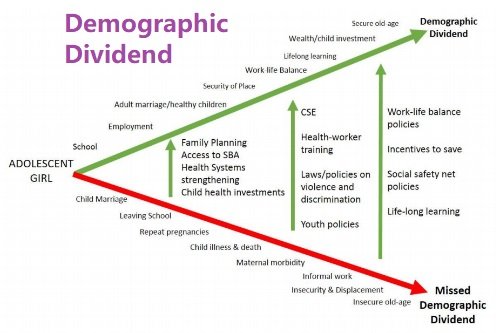AWIP, Economics, GS P6 (Economy, Geography, Environment...)
Q. Do you think that realization of the benefits of the potential demographic dividend that India is expected to experience roughly after 2025, is automatic? Give reasons in support of your answer.
The realization of the benefits of the potential demographic dividend in India is not automatic. A demographic dividend refers to the economic growth potential that can result from shifts in a country’s age structure, primarily when the working-age population is larger than the non-working-age population. For India to capitalize on this demographic opportunity, several pro-active steps and policies need to be implemented. Here are the key reasons why realizing the benefits of the demographic dividend requires deliberate action:
1. Education and Skill Development
- Quality Education: Access to quality education at all levels is crucial. The current education system needs significant improvements in terms of infrastructure, teacher quality, and curriculum relevance. Without a solid educational foundation, the workforce will lack the basic skills necessary for productivity.
- Vocational Training and Skill Development: A significant portion of the Indian workforce is engaged in informal sectors. Comprehensive skill development programs and vocational training are essential to equip young people with the skills demanded by modern industries.
2. Employment Opportunities
- Job Creation: The economy must generate sufficient employment opportunities to absorb the large number of young people entering the job market. This requires robust industrial growth, support for small and medium-sized enterprises (SMEs), and encouragement of entrepreneurship.
- Formalization of the Informal Sector: A significant part of India’s workforce is employed in the informal sector, which often lacks job security and benefits. Formalizing this sector can improve job quality and security, contributing to economic stability.
3. Economic Policies and Infrastructure
- Favorable Economic Policies: Pro-business policies, ease of doing business, and support for startups are critical to fostering a conducive environment for economic growth. Regulatory reforms can attract both domestic and foreign investments.
- Infrastructure Development: Adequate physical infrastructure, including transportation, energy, and communication networks, is necessary to support economic activities and industrial growth.
4. Health and Well-being
- Healthcare Access: A healthy workforce is vital for productivity. Ensuring access to quality healthcare services, sanitation, and nutrition can significantly impact the working-age population’s productivity and longevity.
- Population Health: Addressing public health issues, such as maternal and child health, communicable diseases, and non-communicable diseases, is essential for maintaining a healthy workforce.
5. Gender Equality and Women’s Participation
- Empowering Women: Encouraging higher participation of women in the workforce can significantly boost economic growth. This requires removing barriers to education, employment, and equal pay for women.
- Supporting Working Mothers: Providing facilities such as maternity leave, childcare services, and flexible working hours can help more women join and remain in the workforce.
6. Social Stability and Governance
- Effective Governance: Good governance, transparency, and efficient public services are necessary to implement policies effectively and maintain social stability.
- Social Cohesion: Addressing social inequalities and ensuring that the benefits of growth are widely shared can prevent social unrest and promote inclusive development.
7. Technological Advancements and Innovation
- Digital Literacy: Promoting digital literacy and ensuring access to digital tools can enhance productivity and innovation.
- Research and Development: Investment in research and development can drive technological advancements and create high-value jobs.
8. Environmental Sustainability
- Sustainable Development: Balancing economic growth with environmental sustainability is crucial. Policies promoting renewable energy, sustainable agriculture, and conservation of natural resources are necessary for long-term economic health.
Conclusion
While India has the potential to reap significant benefits from its demographic dividend, these benefits are not guaranteed and require strategic and sustained efforts across multiple sectors. Investments in education, skill development, healthcare, infrastructure, and employment generation, along with policies that promote economic growth and social stability, are essential. The government, private sector, and civil society must work together to create an enabling environment that can transform the demographic potential into real economic gains.


